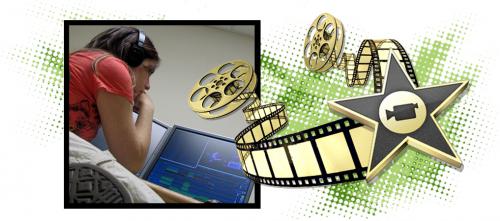
Image Credit:
As instructors, we all know how haggard most students look on the day that a paper is due—the sunken cheeks, the bleary eyes, the undaunted yawns all signal to me that heady material isn’t going to be as quickly (or as enthusiastically) received as usual. So, many of us make it a point to have some sort of fun activity on the day that a paper is due. We all know the kind of activity I’m talking about—the kind where students don’t have to have read or prepare prior to coming to class. I’ve been experimenting lately with making fun, paper-due-date activities using the technologies available to us in the DWRL computer classrooms. My most recent experiment, when my students turned in Paper 2, was to see what happened if I asked my students to make 30-second long videos about their favorite city using iMovie. I was quite surprised with the results.
Whenever I introduce a novel activity like the iMovie workshop, I initially encounter some resistance. As I’m walking around the class to check on how my students are doing, I often notice that a few of my students are visibly frustrated with the new and unfamiliar program. Some of my students documented their discomfort in their Learning Record observations last week, and I learned that, for a couple students, the activity “was somewhat frustrating initially” and “interesting but very overwhelming at first.” Reading these types of observations reminds me that not all students are as tech-savvy as I assume they are.
These observations also help me think about ways to boost my students’ confidence and skills in the workshop environment. On my rounds, I often make a beeline for those struggling students and show them simple things on iMovie that have impressive effects (like adding text over the images that they imported into the program, or transitioning between images, or incorporating a map). With a small amount of confidence in their video editing skills, students let go of their inhibitions and start experimenting with the program’s many effects. In other observations, I learned that students “never realized all of the things you could do with [iMovie], from adding effects, to music, to words and sounds,” and that, for one student, “playing with iMovie on the computers during class was the highlight of my day!” These moments of confidence and skill-building are great results from such a low-stakes, unstructured, and fun activity.
Since the final project for my course, Rhetoric of Suburbs & Slums, is a group video, the iMovie workshop isn’t just an unrelated activity for the goals of my course. Students gain familiarity and a few skills in importing, editing, and exporting. Many students also end up reflecting on their own habits, such as one student who observed that “it was interesting to try a new program that I see everyday, but never open. It made me think about all the programs that are unused on my computer, sitting there, but never used. All it takes is a click to try something new, and it adds to my knowledge!” Another student stressed that “This quick tutorial showed me how to edit videos and slide shows in addition to adding effects. I'll definitely be able to use this skill in the future!” My main goal for this activity is to allow students to de-stress after a paper. Yet, sneakily, I’m preparing them for their final project, too.
I hope to continue experimenting with these low-stakes, high-fun classroom activities using new programs. After Friday’s wonderful AVRG workshop on “Using Video in the Literature and Rhetoric Classrooms,” I’m inspired to come up with other activities (such as the suggested classroom activity of juxtaposing recorded poems and images) for the day that Paper 1 is due in my literature class next semester…

